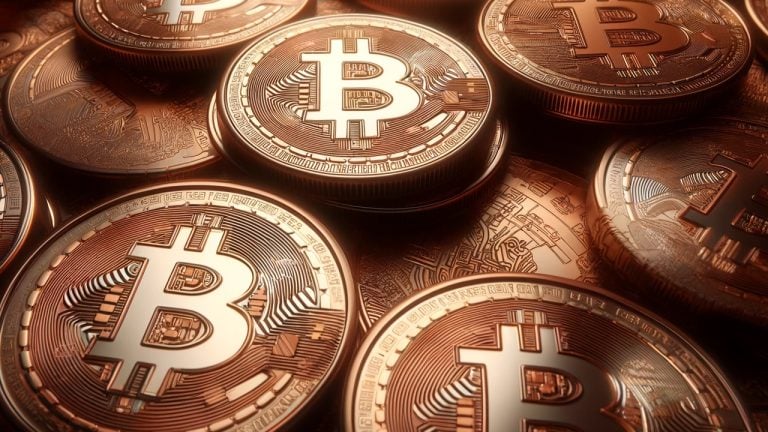 Following the Bitcoin halving event, onchain fees climbed to over $240 per transaction just an hour later, and as of now, a high-priority transfer costs between $52 and $78 per transaction at 10:30 a.m. Eastern Time on Saturday. The increasing fees have prompted a flood of comments from individuals in the crypto space, as this […]
Following the Bitcoin halving event, onchain fees climbed to over $240 per transaction just an hour later, and as of now, a high-priority transfer costs between $52 and $78 per transaction at 10:30 a.m. Eastern Time on Saturday. The increasing fees have prompted a flood of comments from individuals in the crypto space, as this […]
A billion-dollar bank in the US is reportedly facing a potential class-action lawsuit for the second time in about three years over allegedly hammering customers with “crippling” overdraft fees. Customers LaNita Criswell and LaSheena Neal say Frost Bank’s history of imposing $35 overdraft fees on transactions that do not exceed account balances is in breach […]
The post Billion-Dollar Bank Accused of Charging ‘Crippling’ Overdraft Fees As Customers Launch $5,000,000 Lawsuit: Report appeared first on The Daily Hodl.
 Based on a recent analysis, numerous outdated bitcoin mining devices likely powered up in response to the latest uptick in bitcoin’s value. However, with the anticipated block reward halving, it’s projected that around 100 exahash per second (EH/s) of computing power might be disconnected after the event. Bitcoin Miners Enjoy Revenue Boost, Yet Face Potential […]
Based on a recent analysis, numerous outdated bitcoin mining devices likely powered up in response to the latest uptick in bitcoin’s value. However, with the anticipated block reward halving, it’s projected that around 100 exahash per second (EH/s) of computing power might be disconnected after the event. Bitcoin Miners Enjoy Revenue Boost, Yet Face Potential […] Recent statistics reveal that the layer two (L2) network Arbitrum has experienced a significant increase in daily transactions. On Tuesday, the network’s daily transactions even exceeded those on the Ethereum platform. Additionally, following Ethereum’s Dencun upgrade, other L2 networks such as Optimism have also witnessed an uptick in activity. Arbitrum Transfers Spike Metrics indicate that […]
Recent statistics reveal that the layer two (L2) network Arbitrum has experienced a significant increase in daily transactions. On Tuesday, the network’s daily transactions even exceeded those on the Ethereum platform. Additionally, following Ethereum’s Dencun upgrade, other L2 networks such as Optimism have also witnessed an uptick in activity. Arbitrum Transfers Spike Metrics indicate that […]

Spot Bitcoin ETFs could trigger unwanted consequences for crypto exchanges like Coinbase due to lower transaction fees, according to ETF analysts.
While the crypto community eagerly awaits the possible approval of a spot Bitcoin (BTC) exchange-traded fund (ETF) in the United States, some analysts are warning this could potentially trigger unwanted consequences for cryptocurrency exchanges.
Several industry observers have predicted that a spot BTC ETF could start trading in early 2024, in an event that, when paired with Bitcoin’s upcoming block reward halving expected in April, Blockstream CEO Adam Back believes could propel BTC to $100,000.
Bitcoin proponents such as Jan3 CEO Samson Mow have said that approval of a spot Bitcoin ETF in the U.S. could even drive Bitcoin as high as $1 million in the “days to weeks” following.

Bitcoin miners are the main beneficiaries of current sky-high transaction fees, data shows, but many longtime market participants have little time for complaints.
Bitcoin (BTC) on-chain transaction fees are dividing opinion as the cost of sending BTC skyrockets.
Data from statistics resource BitInfoCharts puts the average transaction fee at nearly $40 as of Dec. 17.
The latest wave of Bitcoin ordinal inscriptions have resulted in a fresh wave of elevated transaction fees for all network users — but some believe that they are here to stay.

A 95 year-old woman says she’s going through a nightmare scenario, with scammers draining her account and the bank demanding she repay thousands of dollars stemming from the criminal’s spending spree. Florida resident Virginia Weimer initially lost $13,000 after a scammer gained access to her BofA checking account, reports the NBC-affiliated news station WFLA. Although […]
The post Criminal Drains 95 Year-Old Woman’s Bank of America Account – Now Bank Wants $4,237 in Overdraft Fees appeared first on The Daily Hodl.

This latest report from Cointelegraph Research dives into the tsunami of solutions coming onto the market that improve security, privacy and speed from existing protocols.
The long-awaited “crypto spring” may be upon us as Bitcoin (BTC) and other cryptocurrency markets rise in anticipation of a full-on bull market.
Over the recent crypto winter, many different projects have been growing, gaining users and building new networks. Some of these, like Polygon, are layer-2 (L2) solutions to help scale the primary protocol, Ethereum. But what are the implications of L2s? Are they a better protocol to build on or invest in? Are other layer 1s (L1s) doing anything to stay competitive?
These questions and more are the focus of a new report from the Cointelegraph Research Terminal. The report looks at up-and-coming projects in the cryptoverse, as well as case studies for L1s like Avalanche and Hedera and how they compare to the new tech that is on the rise.
Download the report on the Cointelegraph Research Terminal.
Cointelegraph’s “L1 vs. L2: The Blockchain Scalability Showdown” report is a primer to why scaling solutions are necessary for the shortcomings of L1s. The report provides explanations of what is currently going on in the world of scalability solutions to bridges and projects that focus on interoperability.
Layer-1 blockchains, such as Bitcoin and Ethereum, are base protocols that can be used in conjunction with third-party layer-2 protocols and are also known as mainnets or primary chains.
A layer-0 (L0) protocol allows developers to combine elements from different L1 and L2 protocols while retaining their own ecosystem to heighten interoperability.
L2 protocols enable thousands of low-value transactions to be processed after validation on parallel blockchains, with records then being transferred to the main blockchain or mainnet to ensure they are immutably recorded. This report will help get the reader ready for “crypto summer” with all the information and insights to make better-informed decisions.
As veterans in the blockchain space know, Ethereum gas fees have been a significant issue, sometimes costing users more in the Ether (ETH) transaction cost (measured in gwei) than the value of the underlying asset. As the chart below shows, the price of transactions on Ethereum can fluctuate dramatically, leaving users with an unpredictable experience that can hurt further adoption.
This sparked the creation of solutions to combat the issue, as well as increased scalability, including transactions per second (TPS), interoperability and ease of user experiences for developers and users.

TPS is one crucial factor that separates newer protocols from the older generations, such as Bitcoin and Ethereum. Bitcoin and Ethereum act as their own L1s but do not have intrinsic solutions to operating at speeds comparable to newer networks, as seen in the table below.
Today, there are layer-0 protocols that serve as a base layer in which different protocols can work interoperably. Layer-2 protocols are built on top of L1s to help fill in and overcome gaps that may exist on the L1.
For example, if a protocol has a low TPS, an L2 may provide an inexpensive and efficient way to still use the same programming language and infrastructure of the L1 for security.

The report provides several insights, including the top emerging trends that are leading the narrative of protocols outside of the traditional L1s, such as asset tokenization and account abstraction.
Asset tokenization, including the digital representation of real-world assets (RWA) onto decentralized ledger protocols, will play a significant role in the spread of next-generation protocols.
The migration of assets to these protocols will increase transaction congestion as adoption rates climb. This increased adoption also has consequences, including the need to make custody for average users easier. This is where the next trend, account abstraction, comes into play.
Account abstraction will help user experiences by removing requirements like keeping seed phrases for account recovery. It could also allow for the batching of smart contract executions like complex payment structures to be simplified. By making user experiences easier, L0s and L2s can help spur the next leg of mass adoption.
Cointelegraph Research’s latest report is a starting place to help analyze these newer protocols. The report also includes insider insights from industry professionals who are on the cutting edge of different technologies in the decentralized ledger space.
Cointelegraph’s Research department comprises some of the best talents in the blockchain industry. Bringing together academic rigor and filtered through practical, hard-won experience, the researchers on the team are committed to bringing the most accurate, insightful content available on the market.
The research team comprises subject matter experts from across the fields of finance, economics and technology to bring the premier source for industry reports and insightful analysis to the market. The team utilizes APIs from a variety of sources in order to provide accurate, useful information and analyses.
With decades of combined experience in traditional finance, business, engineering, technology and research, the Cointelegraph Research team is perfectly positioned to put its combined talents to proper use with the “L1 vs. L2: The Blockchain Scalability Showdown” report.
The opinions expressed in the article are for general informational purposes only and are not intended to provide specific advice or recommendations for any individual or on any specific security or investment product.

Patreon creators had difficulties getting paid in August, while OnlyFans once tried to ban porn on the platform, forcing creators to look at alternatives, including Web3.
Adult content creators have continued to shift towards decentralized versions of OnlyFans and Patreon, after recent payment difficulties and the ever-present threat of being de-platformed.
Leon Lee, founder and CEO of Only1 — a decentralized version of OnlyFans — tells Cointelegraph there has been a recent power shift from intermediaries to content creators, thanks to Web3.
“The role of intermediaries are diminishing while the role and earnings of creators are increasing,” said Lee.
In August, creators on Patreon reported having difficulties withdrawing their earnings from the platform as payments were being flagged as fraudulent by banks.
I told the credit card company the charge was valid, fine. Patreon sent an email saying "click here to update your payment" and that link goes to a 404 error. My list of supported creators is gone, I have to try to remember who I was supporting - there is nothing on the site 2/
— Jason Pargin, author of John Dies at the End, etc (@JasonKPargin) August 2, 2023
Many content creators also haven’t likely forgotten when OnlyFans tried to ban sexually explicit content in 2021, only to reverse the decision days later.
Speaking to this, Lee argues that creators will always be at risk of being deplatformed as long as they stay on centralized platforms using traditional payment rails.
“Creators are still at risk of being deplatformed and are not realizing their full earning potential.”
Only1 was launched on the Solana blockchain in March 2023 — backed by Animoca Brands. However, the platform is just one out of many startups looking to capture the magic of adult subscription platforms with a decentralized crypto twist.
1/ Introducing the Creator Economy 4.0
— Only1 (@JoinOnly1) August 22, 2023
Traditional creator subscription platforms fell short when it comes to payments, incentives and censorship. This is all about to change, starting here on @solana.
Read on pic.twitter.com/TABSvzO1HX
In 2022, OnlyFans model Allie Rae created a crypto-powered adult content platform WetSpace, as an alternative to OnlyFans.
Rae told Cointelegraph in December 2022 that she created the platform to circumvent the payment pressures that creators on platforms like OnlyFans were receiving from banks:
“I started to figure out that the banks really were largely in part the driving force behind some of those decisions that platforms were having to make. And so that naturally led to me: How do you get rid of the banks? And crypto came out like a knight in shining armor.”
More recently, creators on OnlyFans started flocking to Friend.tech, a new decentralized social media platform built on Coinbase’s layer-2 network Base.
gm web3. im shaking rn officially 1 / 292 FT girl@friendtech when merch? i'll rock it. pic.twitter.com/Qm84AajCWt
— gracie♡ (@ilovegraciexo) September 4, 2023
Lee believes a mass migration event will happen when more creators realize they don’t want to be shackled by censorship rules imposed by a centralized intermediary.
“Creators are already waking up to the fact and are becoming less dependent on intermediaries to monetize,” Lee said.
He acknowledged that TV producers, advertisers and brands will maintain a market share in the creator economy, but said a true peer-to-peer payment infrastructure like blockchain is the “next logical step” for creators:
“By removing the dependency on traditional payment processors, a web3 platform and its community can have full autonomy over the types of content allowed,” he said, adding:
Since the OnlyFans adult content censorship, creators have been creating ‘backup accounts’ on different platforms due to such deplatform risk.”
Proof of Peach, SEXN and Keyhole are three other adult entertainment platforms working in the Web3 space.
Related: DuckSquad — First decentralized venture capital NFT launches on Only1
Lee believes more creators will eventually flock to decentralized platforms that provide them with “full autonomy” over their content and full ownership rights to the money they make:
“It is an inevitable future where there will no longer be any intermediaries between fans and creators — this is an obvious but unrealized potential of blockchain technology.”
Magazine: NFT Creator: ‘Holy shit, I’ve seen that!’ — Coldie’s Snoop Dogg, Vitalik and McAfee NFTs

Network, futures and user data all point toward Ethereum potentially charting a new course.
Ether (ETH) price has been dealing with some strong headwinds and on Sept. 11, the price of the altcoin endured a critical test when it plunged to the $1,530 support level. In the days that followed, Ether managed to stage an impressive recovery, by surging by 6%. This resurgence may signal a pivotal moment, following a month that had seen ETH endure losses of 16%.
Even with the somewhat swift recovery, Ether’s price performance raises questions among investors about whether it has the potential to climb back to $1,850, and ETH derivatives and network activity might hold the key to this puzzle.

Macroeconomic factors have played a significant role in mitigating investor pessimism given that inflation in the United States accelerated for the second consecutive month, reaching 3.7% according to the most recent CPI report. Such data reinforces the belief that the U.S. government's debt will continue to surge, compelling the Treasury to offer higher yields.
Scarce assets are poised to benefit from the inflationary pressure and the expansive monetary policies aimed at bridging the budget deficit. However, the cryptocurrency sector is grappling with its own set of challenges.
There's the looming possibility of Binance exchange facing indictment by the U.S. Department of Justice. Furthermore, Binance.US has found itself entangled in legal battles with the U.S. Securities and Exchange Commission (SEC), leading to layoffs and top executives departing from the company.
Besides the regulatory hurdles faced by cryptocurrencies, the Ethereum network has witnessed a notable decline in its smart contract activity, which is at the core of its original purpose. The network still grapples with persistently high average fees, hovering above the $3 mark.

Over the past 30 days, the top Ethereum dApps have seen an average 26% decrease in the number of active addresses. An exception to this trend is the Lido (LDO) liquid staking project, which saw a 7% increase in its total value locked (TVL) in ETH terms during the same period. It's worth mentioning that Lido's success has been met with criticism due to the project's dominance, accounting for a substantial 72% of all staked ETH.
Vitalik Buterin, co-founder of Ethereum, has acknowledged the need for Ethereum to become more accessible for everyday people to run nodes in order to maintain decentralization in the long term. However, Vitalik does not anticipate a viable solution to this challenge within the next decade. Consequently, investors have legitimate concerns about centralization, including the influence of services like Lido.
A look at derivatives metrics will better explain how Ether’s professional traders are positioned in the current market conditions. Ether monthly futures typically trade at a 5 to 10% annualized premium — a situation known as contango, which is not unique to crypto markets.

The premium for Ether futures hit its lowest point in three weeks, standing at 2.2%, indicating a lack of demand for leveraged long positions. Interestingly, not even the 6% gain following the retest of the $1,530 support level on Sept. 11 managed to push ETH futures into the 5% neutral threshold.
One should look at the options markets to better gauge market sentiment, as the 25% delta skew can confirm whether professional traders are leaning bearish. In short, if traders expect a drop in Bitcoin’s price, the skew metric will rise above 7%, while periods of excitement typically have a -7% skew.

On Sept. 14 the Ether 25% delta skew indicator briefly shifted to a bullish stance. This shift was driven by put (sell) options trading at an 8% discount compared to similar call (buy) options. However, this sentiment waned on Sept. 15, with both call and put options now trading at a similar premium. Essentially, Ether derivatives traders are displaying reduced interest in leverage long positions, despite the successful defense of the $1,530 price level.
On one hand, Ether has potential catalysts, including requests for a spot ETH exchange-traded fund (ETF) and macroeconomic factors driven by inflationary pressure. However, the dwindling use of dApps and ongoing regulatory uncertainties create a fertile ground for FUD. This is likely to continue exerting downward pressure on Ether's price, making a rally to $1,850 in the short to medium term appear unlikely.
This article is for general information purposes and is not intended to be and should not be taken as legal or investment advice. The views, thoughts, and opinions expressed here are the author’s alone and do not necessarily reflect or represent the views and opinions of Cointelegraph.